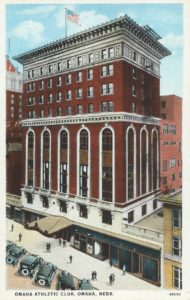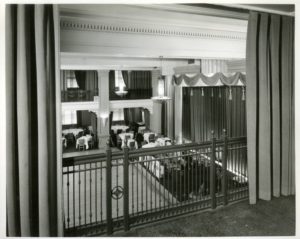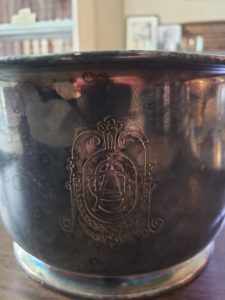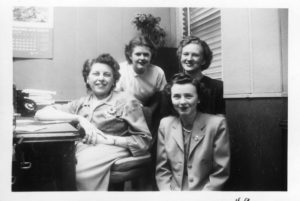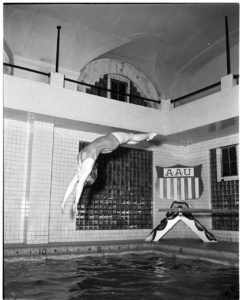By Rita Shelley
When the derelict 10-story property at 1714 Douglas Street was demolished on February 10, 1992, fifty years of the Omaha Athletic Club at that location ended in a cloud of smoke. The club had closed in 1970 and was purchased by the Federal Reserve in 1977. The Reserve offered the building for sale in the mid-80s, but it remained unoccupied until its demolition.[1]
With a crowd of fifty assembled blocks away to watch the demolition on a clear, cold morning, Anderson Excavating and Wrecking Company detonated the building with 250 pounds of explosives. Bus routes in the neighborhood had been temporarily re-routed. The originally planned blast time of 8 a.m. had been postponed until 8:40 to allow time for the conclusion of Mass at St. Mary Magdalene Catholic Church three blocks away.[2]
Postcard image of the Omaha Athletic Club at 1714 Douglas Street, c. 1925. The Hotel Fontenelle is just visible to the left. Courtesy of the Douglas County Historical Society.
While the Douglas Street address had been the club’s home from 1918 until it closed in 1970, the club’s history actually dated back much farther. Beginning in 1888, the club had been housed at 1415 Farnam. That building’s second floor was outfitted as a gym with the intention of a men’s-only club for an exclusive roster of members. In 1891, the club moved a block east to a building that developer John Redick rented for $1,000 a year. With a membership of only thirty-eight, the club nevertheless hosted an event showcasing members’ gymnastics and diving skills. The following year, the club team took on the Bohemian Turners in tug-of-war. Entertainments also included sparring and wrestling matches.[3]
But by early 1893, the club was fighting for its life. Monthly revenue from bowling, billiards, locker rental, cigars, boxing, fencing, and “entertainments” was short of expenses by $200 a month. Rent was past due. Boxing matches were poorly attended; the theory was that the public perceived the matches to be fixed and, even so, Omaha lacked sufficient interest for boxing to turn a profit. Raising annual membership fees to try to cover expenses had the opposite effect when many members quit. It was suggested that if fifty men were to pay off the club’s indebtedness and if fees were more affordable, the club would be back on a firm footing. Membership, it was also suggested, should include free bowling, boxing, and fencing.[4]
Within six months, membership and income were declared sufficient to cover expenses, marking the beginning of an era of apparent solvency that lasted until the 1930s. Use of the bowling alley was now free to members on Wednesdays; Saturday mornings were set aside as “ladies’ day.”[5]
The club was doing so well, in fact, that it commissioned a new building for its headquarters, located at 17th and Douglas. Billed as the dreamchild of a small group of influential Omahans, its ten stories made it the tallest building in the city at the time. Designed by architect John Latenser and Sons, it had a gymnasium, ballroom, swimming pool, rooms upstairs rentable to temporary guests, meeting rooms, and a penthouse. There was a nine-hole golf course in the basement and handball and squash courts on the roof. Upon its formal, members-only opening in December 1918, the club declared itself a showpiece of downtown Omaha and a site of leisure time activities for businessmen.[6]
Based on mentions in the Omaha World-Herald, the club likely hosted nearly as many social events as athletic ones during its history. In the 1920s, it hosted a swimming meet, amateur boxing matches, and a regional bowling tournament with teams from Minneapolis, Kansas City, and Des Moines. There were boxing matches featuring nationally known fighters, as well as basketball and billiards tournaments. It also hosted society mavens’ lunches, a dinner dance for the Aksarben chapter of the Eastern Star, and an annual Christmas party for children. One dinner featured a musical with a song for each course, beginning with “Yes We Have No Bananas.” A banquet honored a New York feminist who traced feminist progress from primitive society to modern times.[7]
View of the Omaha Athletic Club’s bandstand, dance floor, and part of the dining room from an upper balcony, 1944. Courtesy of the Durham Museum’s Bostwick-Frohardt Collection.
Another era of instability began in 1933 when it was announced that membership had dwindled from 1,000 to 400 members. The organization was $25,000 in debt, and the club was closed.[8] Furnishings and inventory were auctioned off, including pieces from the billiard parlor, barber shop, restaurant, and the bowling alley.[9] But the club got back on its feet and reopened again in 1936. With an investment of $100,000, the newly decorated and furnished club’s amenities included a bowling alley, pool and billiards rooms, a swimming pool, gym facilities, and squash and handball courts. There were also rooms for bridge and card games. The wall of a new bar depicted a boar hunt; a second bar had a South Seas island theme. The recovery was billed as a “triumph for Omaha…placing Omaha among the nation’s leading cities.”[10]
Silver champagne bucket monogrammed with Omaha Athletic Club logo. It’s unclear whether this is one of the pieces auctioned off 1933, or if it dates to the period after the club reopened. Courtesy of Douglas County Historical Society.
In 1949, the club made dramatic headlines when police seized and destroyed ten slot machines during a morals squad raid. The club’s manager was charged with keeping a gambling room and fined $500.[11]
With the exception of swim meets during the 1950s and 60s, the club’s activities shifted during these decades to more social events and less athletics. In the 1960s, holiday parties were hosted by the Mid-Continent Horse Show Association, the New Neighbors’ League, and the National Association of Railway Business Women. Aksarben princesses and the Minerva Mothers Club of Sigma Alpha Epsilon Fraternity hosted luncheons.[12]
A final era of low membership and debt caused the club to close in 1970. Developers showed interest in the building, but no financially feasible plan materialized. Hence, the eight-second demolition in 1992. The east side of the building went first, its rubble falling into the hole left by the previous demolition of the neighboring Baird Building. Two sirens sounded the all clear.[13]
Bonus Pictures:
Four employees in the Omaha Athletic Club offices. They are identified from left to right as Jennie Aldera, Shirley Smith, Irene Ehlers (back), and Helen Sys (front), 1948. Courtesy of Douglas County Historical Society.
A woman mid-dive at the Omaha Athletic Club pool, c. 1953. Courtesy of the Durham Museum’s Paskach Collection.
[1] “Old Athletic Club Will be Sold.” Omaha World-Herald. 24 October 1983, p. 13.
[2] “Athletic Club Blasted into Rubble.” Omaha World-Herald. 10 February 1992, p. 1.
[3] “Omaha Athletic Club: An Excellent Program Rendered Last Night at the Club House.” Omaha World-Herald. 25 May 1892, pg. 2.
[4] “A Slim Week for Sports: The Affairs of the Omaha Athletic Club Entertainment Not Profitable.” Omaha World-Herald. 26 February 1893, p.14.
[5] “Omaha Athletic Club Notes.” Omaha World-Herald. 4 June 1893, p. 2.
[6] “$750,000 Omaha Athletic Club Starts Ten Story Building on Douglas Street”. Lincoln Star Journal, 23 September 1917.
[7] “Calls Women Victims of Inferiority Complex. Doris Stevens Tells Professional Sisters That Theory of “Place in the Home Is Old-Fashioned.” Omaha World-Herald. 28 September 1927, p. 1.
[8] “Athletic Club, Born in Times of Adversity, Succumbs in Losing Financial Struggle.” Omaha World-Herald. 21 May 1933, p. 3.
[9] “Furniture Auction.” Omaha World-Herald. 8 April 1934, p.19.
[10] “Omaha’s New Athletic Club Opens.” Omaha Bee. 20 February 1936.
[11] “Trial for Athletic Club.” Omaha World-Herald. 30 December 1951, p. 2.
[12] “Mothers’ Group Slates Session.” Omaha World-Herald. 4 October 1960, p. 17.
[13] “Athletic Club Blasted into Rubble.” Omaha World-Herald. 10 February 1992, p. 1
